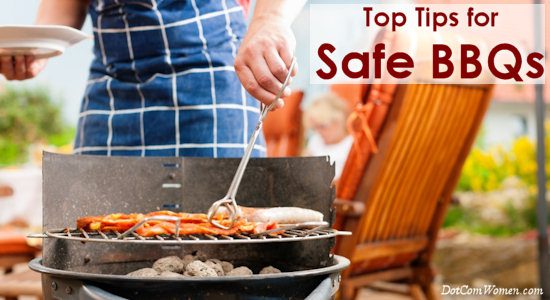Top Tips for Safe BBQs
A nice barbecue with a group of friends and family is one of the summertime’s greatest and most simple pleasures. However, barbecues provide certain risks and some basic precautions should be taken to ensure that yours is memorable for the right reasons.

Cases of food poisoning double during the summer months and this can be linked in no small part to the increase in barbecues. Yet, if you follow some basic principles, your barbecue will not add to these statistics.
Handling Raw Meat
Most people are aware that raw meats are not safe to consume, but many do not realise that the germs from raw meat can be easily passed to other foods served at a barbecue. This is known as cross-contamination. To avoid this particular problem, several steps can be taken.
First of all, you should always wash your hands after touching raw meat, before you touch any other food. This will prevent the spread of germs from your hands onto ready-to-eat food, like salad, sandwiches or meats you have already cooked.
Secondly, raw meat and cooked meat should be handled using separate utensils. This will prevent the germs from being transmitted via items like tongs.
Finally, it is important to be aware of which surfaces raw meat has been on. These surfaces should be wiped before other food is placed on them. For this reason, it is good practice to keep raw meat in sealed containers, away from other food. Plates which have been used for raw meat should not be re-used for cooked meat or other food until they have been cleaned.
Cooking Meat
Aside from the handling of raw meat, another potential problem with barbecues comes from the cooking of the meat itself. Although some meats, such as steaks, can be served rare, most meats need to be cooked thoroughly before consumption. This is especially true of poultry, like chicken, or minced meats, like sausages or burgers.
Undercooked meats are one of the largest causes of food poisoning and can lead to some of the most serious cases as well. To avoid undercooking meat, always make sure that your barbecue is hot enough to cook the meat. The coals on the barbecue should be glowing red before use.
While cooking the meat, make sure you move it around and turn it regularly. This will help to ensure that it is cooked as evenly as possible, so there are no undercooked sections of meat remaining.
Moreover, do not assume meat is cooked all the way through, just because the outside looks well cooked. In order to check that meat is cooked properly, cut it at the thickest part and check that the meat inside is hot. If any of the meat is pink, or if the juices do not run clear, continue cooking.
Keep Food Cool
Meat is not the only food at a barbecue that can cause food poisoning and many people overlook the dangers of leaving food in direct sunlight. Doing so allows the germs related to food poisoning to multiply.
As well as keeping the food out of direct sunlight, many foods should not be left out of the refrigerator for more than a couple of hours. Foods in this category include sandwiches, yoghurts, cakes, rice, salads, milk and ham.
Barbecues are a perfect way to bring people together and the risks associated are minimal if the right precautions are considered.
This article comes to you from CS Healthcare a specialist provider of affordable health insurance to those that work, or have worked, in the civil service, public service and not-for-profit sector, including their families.
This article is intended as general information only. If you or a family member have any medical concerns, please contact your GP or medic.
CS Healthcare is authorised by the Prudential Regulation Authority and regulated by the Financial Conduct Authority and the Prudential Regulation Authority – reg no. 205346. The maximum joining age is 74 years and 11 months unless you are switching from a previous insurer in which case the maximum joining age is 69 years and 11 months.
Kyle Williams is a freelance writer who specialises in general health and fitness advice.


